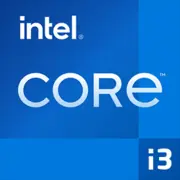Intel Core i3-8300T

インテルコアi3-8300T: 予算組み立て向けレビューと実践ガイド (2025)
はじめに
インテル第8世代のプロセッサーは、発売から何年経っても中古市場や完成品ソリューションで人気を保っています。2018年に発売されたCore i3-8300Tは、そのエネルギー効率とパフォーマンスのバランスで注目を集め続けています。本記事では、2025年にこのCPUがどのような人に適しているか、基にしたPCの組み立て方、注意すべき点について解説します。
1. 主な仕様: アーキテクチャとパフォーマンス
Coffee Lakeアーキテクチャ
Core i3-8300Tは、Kaby Lakeに比べて進化した14nmのCoffee Lakeマイクロアーキテクチャに基づいています。主な特徴は以下の通りです:
- 4コア / 4スレッド — ハイパースレッディングがないためマルチタスク性能は限られていますが、基本的な作業には十分です。
- ベースクロック3.2 GHz — ターボブーストなしで、熱管理が簡単です。
- L3キャッシュ8MB — 日常的なアプリケーションをスピードアップするのに十分な容量です。
エネルギー効率
TDPは35Wで、コンパクトなシステム(ミニPCやオフィス用の組み立て)に最適です。負荷時でも40–45Wを超えることは少なく、パッシブ冷却や小型のクーラーで対応可能です。
統合グラフィックス
Intel UHD Graphics 630はHDMI 1.4およびDisplayPort 1.2を介して4K@60Hzをサポートしています。このソリューションは次の用途に適しています:
- 動画視聴やオフィスアプリケーションでの作業。
- 軽いゲーム(例:低設定のCS:GOで40–50FPS)。
ベンチマークパフォーマンス
- Geekbench 6: シングルコア — 1149, マルチコア — 3357。
- Cinebench R23: マルチスレッドモードで約2500ポイント。
比較として、現代のRyzen 3 7300(2023)はGeekbench 6のマルチコアで約5000ポイントを獲得しますが、価格は倍近くなります。
2. 対応マザーボード
LGA 1151 v2ソケット
このプロセッサーは300シリーズのチップセットを搭載したマザーボードが必要です:
- H310 / B360 — オーバークロックなしの予算バージョン(オフィス用PCに適しています)。
- H370 / Z370 / Z390 — USB 3.1 Gen2のサポート、大容量のSATAとPCIeポート。
モデル例(新しいもの、2025年):
- ASUS Prime H310M-K R2.0 (~70ドル) — 機能は少ないが安定性あり。
- Gigabyte B360M DS3H (~90ドル) — 4つのDIMMスロット、2つのM.2ソケット。
重要! プラットフォームの古さから、新しいマザーボードの生産はほとんどありません。多くの提案は倉庫の残りやリファビッシュモデルです。
3. 対応メモリ
- タイプ: DDR4-2400(公式)。
- 最大容量: 64GB(マザーボードに依存)。
推奨:
- オフィス作業には8–16GBで十分(例: Kingston Fury DDR4-2400 16GB 約40ドル)。
- PCをメディアセンターとして使用する場合は、デュアルチャネルモードのために2つ目のモジュールを追加することで、グラフィックスパフォーマンスが10–15%向上します。
制限: DDR5のサポートがないため、将来的なメモリアップグレードはプラットフォームを交換しなければなりません。
4. 電源ユニット: 選び方
プロセッサー自体は最大35Wを消費しますが、システム全体の電力消費は構成部品によります:
- ディスクリートGPUなし: 250–300Wの電源ユニットで十分(例: be quiet! SFX Power 3 300W 約45ドル)。
- NVIDIA GTX 1650レベルのグラフィックスカード付き: 400–450Wの電源ユニットを推奨(Corsair CX450M 約60ドル)。
アドバイス: 安定性のために電源ユニットをケチらないでください。予算組の構成でも80+ Bronze認証を持つモデルを選びましょう。
5. 長所と短所
利点:
- 低消費電力と低温。
- オフィスやストリーミングビデオに十分なパフォーマンス。
- H.265のハードウェアデコーディングをサポート。
欠点:
- スレッド数が4つのみ — マルチスレッド性能が弱い。
- 統合グラフィックスは現代のゲームには不向き。
- 古いプラットフォーム(PCIe 4.0やUSB4のサポートなし)。
6. 使用シナリオ
オフィスと学習
- ドキュメント作成、ブラウジング(20以上のタブ)、Zoom。
- 例: i3-8300TベースのPC、16GB DDR4、512GB SSD — リモートワークに最適。
メディアセンター
- HDMIを介してTVに接続、4K HDRの再生。
- KodiやPlexを使用してストリーミング。
軽いゲーム
- 2018年までのゲーム: Dota 2、Overwatch(低設定、720p)。
- エミュレーター(例: PlayStation 2 — 60 FPS)。
7. 競合との比較
AMD Ryzen 3 3300X (2020)
- 利点: 4コア / 8スレッド、PCIe 4.0のサポート。
- 欠点: TDPが高い(65W)、専用のグラフィックスカードが必要。
- 価格: 約100ドル(新しいAM4マザーボードは依然として入手可能)。
Intel Core i3-12100T (2022)
- 利点: Alder Lakeアーキテクチャ、8スレッド、DDR5。
- 欠点: 価格が高い(約130ドル)、LGA 1700マザーボードが必要。
結論: 2025年において、i3-8300Tは新しいモデルに劣りますが、価格面では優位性があります(新しいCPUは60ドルから)。
8. 組み立てのためのアドバイス
1. ケース: スペースを節約するためにコンパクトなモデルを選びましょう(Fractal Design Node 304など)。
2. 冷却: ボックスクーラーでも問題ありません — 例: Intel E97379-003(約15ドル)。
3. ストレージ: SSDを必ず使用すること(Crucial P3 1TB 約50ドル) — HDDはシステムを遅くします。
4. アップグレード: グラフィックスカードを追加する予定がある場合は、余裕を持った電源ユニットを選んでください。
組み立て例(周辺機器なし約300ドル):
- CPU: i3-8300T(60ドル)
- マザーボード: ASUS H310M-K(70ドル)
- メモリ: 16GB DDR4(40ドル)
- SSD: 512GB NVMe(50ドル)
- 電源: 400W 80+ Bronze(55ドル)
- ケース: Mini-Tower(25ドル)。
9. 最終結論: 誰にi3-8300Tが向いているか?
このプロセッサーを考慮すべき場合:
- オフィス、学習、または家庭用シアター用の安価なPCが必要な場合。
- 静音性と低エネルギー消費が重要な場合。
- 現代のゲームや重いアプリケーションに要求がない場合。
代替案: 予算が許せば、40~60ドル追加してRyzen 5 5500(6コア)またはCore i3-13100Tを購入することをお勧めします。これらはより現代的で将来性があります。
結論
インテルCore i3-8300Tは2025年において、特定のニーズに応えるニッチなソリューションです。ゲーマーやデザイナーには向きませんが、信頼性とミニマリズムが重要な予算ベースのシステムに優れた基盤を提供します。適切な構成部品を選べば、このPCはさらに3〜4年アップグレードなしで使用可能です。
基本
CPUの仕様
メモリ仕様
GPUの仕様
その他
ベンチマーク
他のCPUとの比較
ソーシャルメディアで共有する
または当サイトへのリンクを追加
<a href="https://cputronic.com/ja/cpu/intel-core-i3-8300t" target="_blank">Intel Core i3-8300T</a>